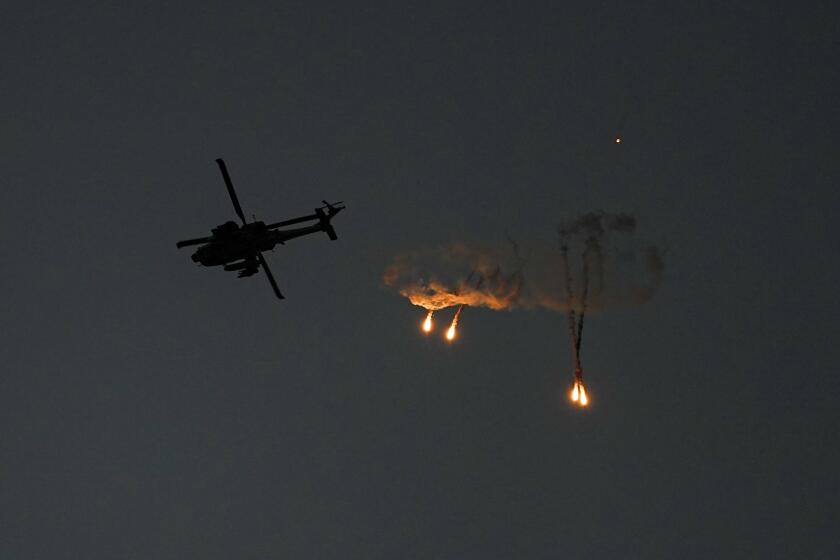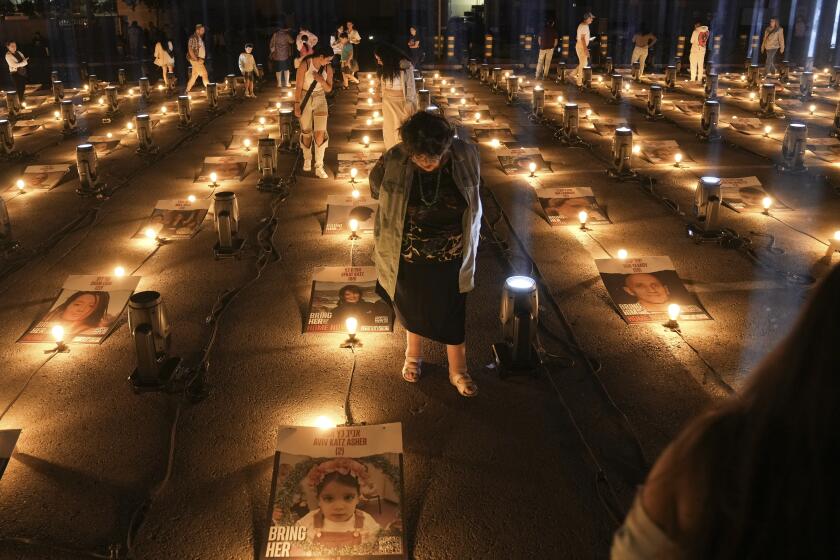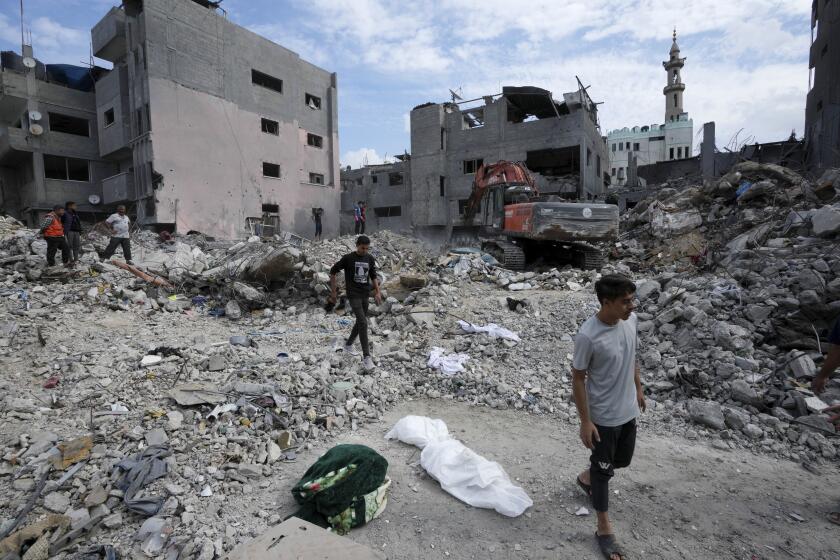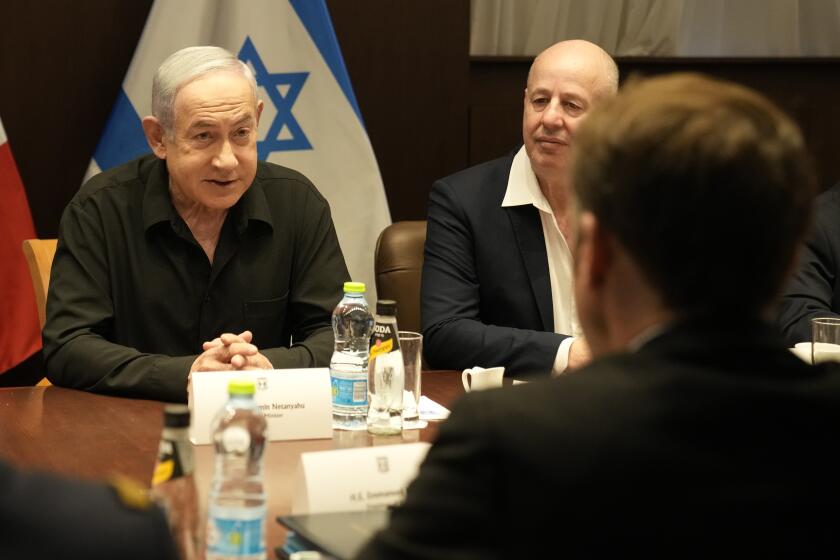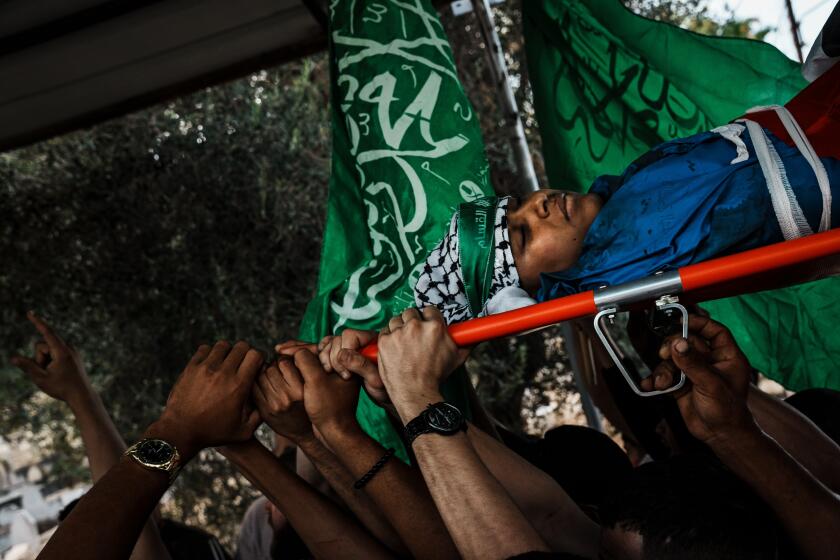32 babies in critical condition are among the patients left at Gaza’s main hospital, U.N. team says

- Share via
KHAN YUNIS, Gaza Strip — A United Nations team said Sunday that 291 patients were left at Gaza’s largest hospital after Israeli troops had others evacuate. Those left included 32 babies in extremely critical condition, trauma patients with severely infected wounds and others with spinal injuries who are unable to move.
The team was able to tour Shifa Hospital in Gaza City for an hour after about 2,500 displaced people, mobile patients and medical staff left the sprawling compound Saturday morning, said the World Health Organization, which led the mission.
“Patients and health staff with whom they spoke were terrified for their safety and health, and pleaded for evacuation,” the agency said, describing Shifa as a death zone. It said more teams will attempt to reach Shifa in coming days to try to evacuate the patients to southern Gaza, where hospitals are also overwhelmed.
Israeli troops are staying in Shifa. Israel’s military has been searching the hospital for a Hamas command center that it alleges is located under the building — a claim Hamas and the hospital staff deny.
Saturday’s mass departure was portrayed by Israel as voluntary, but described by some of those leaving as a forced evacuation.
“We left at gunpoint,” Mahmoud Abu Auf told the Associated Press by phone after he and his family left the crowded hospital. “Tanks and snipers were everywhere inside and outside.” He said he saw Israeli forces detain three men.
Elsewhere in northern Gaza, many people were killed in the urban Jabaliya refugee camp when what witnesses described as an Israeli airstrike hit a crowded U.N. shelter in the main combat zone. It caused massive destruction in the camp’s Fakhoura school, and dozens of people were seen lying motionless, said wounded survivors Ahmed Radwan and Yassin Sharif.
“The scenes were horrifying. Corpses of women and children were on the ground. Others were screaming for help,” Radwan said by phone. AP photos from a local hospital showed more than 20 bodies wrapped in bloodstained sheets.
The Israeli military, which had warned Jabaliya residents and others in a social media post in Arabic to leave, said only that its troops were active in the area “with the aim of hitting terrorists.” It rarely comments on individual strikes, saying only that it targets Hamas while trying to minimize harm to civilians.
“Receiving horrifying images & footage of scores of people killed and injured in another UNRWA school sheltering thousands of displaced in the north of the Gaza Strip. These attacks cannot become commonplace, they must stop. A humanitarian ceasefire cannot wait any longer,” Philippe Lazzarini, the commissioner-general of the United Nations agency for Palestinian refugees, known as UNRWA, said on X, formerly Twitter.
A Times special correspondent in Gaza offers a personal account of living in a place where nowhere feels safe.
“Civilians cannot and should not have to bear this any longer,” U.N. humanitarian chief Martin Griffiths said on X.
Attacks continued in southern Gaza. An Israeli airstrike hit a residential building on the outskirts of the town of Khan Yunis, killing at least 26 Palestinians, according to a doctor at the hospital where the bodies were taken.
Defense Minister Yoav Gallant said Israel’s forces have begun operating in eastern Gaza City while continuing its mission in western areas. “With every passing day, there are fewer places where Hamas terrorists can operate,” he said, adding that the militants would learn that in southern Gaza “in the coming days.”
His comments were the clearest indication yet that the military plans to expand its offensive to the southern areas of Gaza where Israel had told Palestinian civilians to flee early in the war. The evacuation zone is already crammed with displaced civilians, and it was not clear where they would go if the offensive moves closer.
What led to the Shifa Hospital evacuation wasn’t immediately known. Israel’s military said it had been asked by the hospital’s director to help those who would like to leave do so, and that it did not order an evacuation. But Medhat Abbas, a spokesman for the Health Ministry in Hamas-controlled Gaza, said the military had ordered the facility cleared, giving the hospital an hour to get people out.
The U.N. team visiting after the evacuation said 25 medical staff members remained, along with the patients. The World Health Organization said that in the next 24 to 72 hours, pending guarantees of safe passage, more missions were being arranged to evacuate to the Nasser Medical Complex and the European Gaza Hospital in southern Gaza.

Twenty-five of Gaza’s hospitals are nonfunctional due to damage, lack of fuel and supplies and other problems, and the other 11 are only partially operational, according to the WHO.
Israel has said hospitals in northern Gaza were a key target of its ground offensive aimed at crushing Hamas, asserting they were used as militant command centers and weapons depots, which both Hamas and medical staff deny. Israeli troops have encircled or entered several hospitals.
Internet and phone service were restored Saturday to the Gaza Strip, ending a telecommunications outage that forced the United Nations to shut down critical aid deliveries.
The latest war, now in its seventh week, was triggered by Hamas’ Oct. 7 attack in southern Israel, in which militants killed about 1,200 people, mostly civilians, and abducted some 240 men, women and children. Fifty-two soldiers have been killed since the Israeli offensive began, Israel says.
Weeks after Hamas militants paraded her nearly naked body, young Israeli festival-goer Shani Louk is confirmed dead. Many families still await news of their loved ones.
Rescuers in Gaza don’t have the equipment, manpower or fuel to search properly for the living, let alone the dead buried among mounds of rubble.
More than 11,500 Palestinians have been killed in the war, according to Palestinian health authorities. An additional 2,700 have been reported missing, believed buried under rubble. The count does not differentiate between civilians and combatants, but more than two-thirds of those killed were women and children, the authorities say. Israel says it has killed thousands of militants.
Israeli Prime Minister Benjamin Netanyahu said Saturday that the Israeli military would have “full freedom” to operate within the territory after the war. The comments again put him in conflict with U.S. visions for a postwar era in Gaza.
In an op-ed published Saturday in the Washington Post, President Biden said Gaza and the West Bank should be reunited and governed under a “revitalized Palestinian Authority” while world leaders work toward a two-state solution. Netanyahu has long opposed a Palestinian state.
The U.S. is providing weapons and intelligence support to Israel in its offensive against Hamas.
Gaza’s main power plant shut down early in the war, and Israel has cut off electricity. That makes fuel necessary to power the generators needed to run the telecommunications network, water treatment plants, sanitation facilities, hospitals and other infrastructure for Gaza’s 2.3 million people.
Juliette Touma, spokesperson for UNRWA, said 31,700 gallons of fuel arrived Saturday, meant to last for two days, after Israel agreed Friday to allow in that amount for the U.N.’s use. It is also allowing an additional 2,640 gallons to keep the telecommunications systems running.
The U.N. has warned that the amount of fuel being provided is only half the daily minimum requirement.
It was not immediately clear when UNRWA would resume the delivery of aid that was put on hold Friday.
Israel, along with Egypt, had enforced a blockade on Gaza for 16 years, but after the Hamas attack, it ordered a “complete siege,” though some aid and fuel are being allowed in now. Gaza has received only 10% of its required food supplies each day in shipments from Egypt, according to the U.N., and the water system shutdown has left most of the population drinking contaminated water, causing an outbreak of disease.
Dehydration and malnutrition are growing, with nearly all residents in need of food, according to the U.N.’s World Food Program.
In Jerusalem, thousands of marchers — including family members and supporters of the hostages held by Hamas in Gaza — arrived on the last leg of a five-day trek from Tel Aviv, castigating Netanyahu over his handling of the war and pleading with the government to do more to bring their loved ones home.
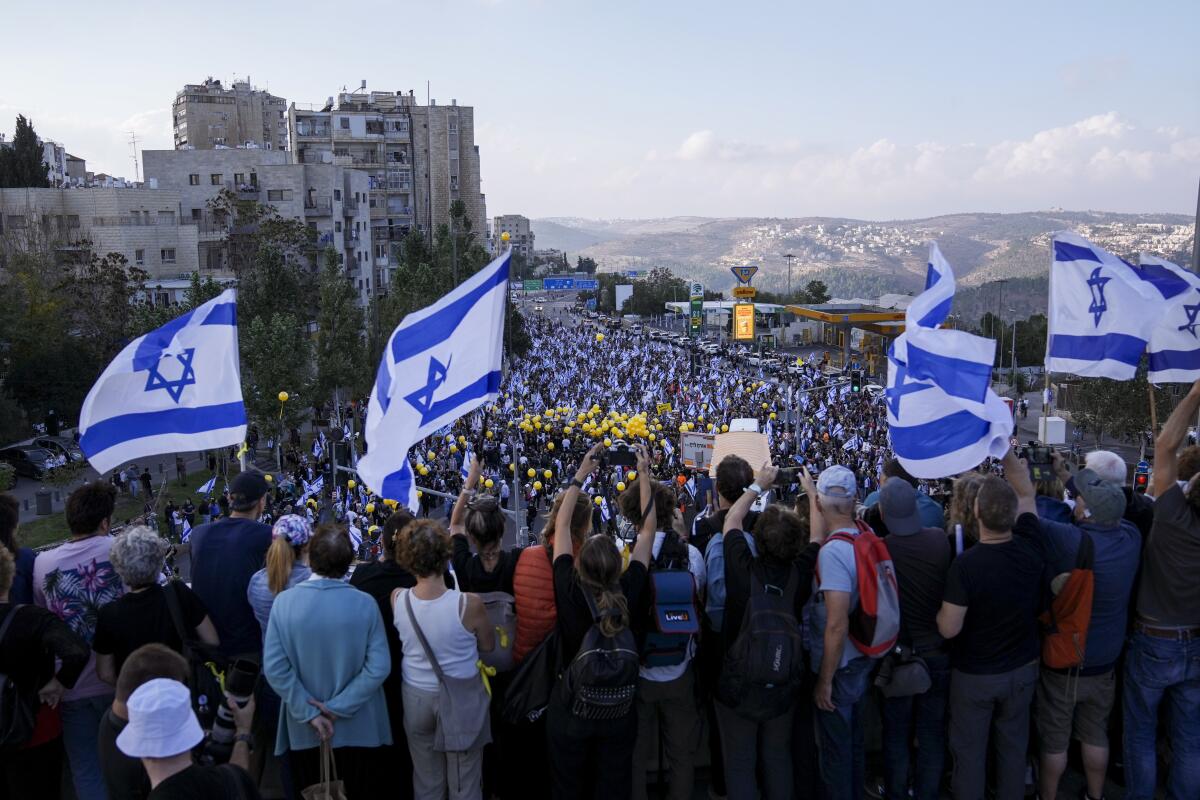
Israel-Hamas war: In a national vigil of sorts, Israelis hope for the return of more than 220 people seized by militants and believed held in Gaza.
Netanyahu said Saturday that Israel’s war Cabinet would soon meet with representatives of the families. “I promise, when we have something to say, we will inform you,” he said.
Rallies over the war were again held in several cities around the world.
Israelis fault Prime Minister Benjamin Netanyahu for security failures that set the stage for war. Few see a path to leadership change amid the crisis.
The Israeli military said its aircraft struck what it described as a hideout for militants in the urban refugee camp of Balata in the occupied West Bank. The Palestinian Red Crescent ambulance service said five Palestinians were killed.
The deaths raised to 212 the number of Palestinians killed in West Bank violence since the war began, making it the deadliest period in the territory since the second Palestinian uprising in the early 2000s.
Violence surges in the West Bank as Israel increases raids to root out militants. Palestinians say the military is using the war as an excuse to crack down.
Some people moving south in Gaza recovered bodies of strangers along the way. “I found these young men inside the car. The car was destroyed,” said Moemen Abu Erban, one man on the move. “Frankly, it is a difficult thing. There is complete destruction.”
The bodies had been placed on a horse cart and covered with blankets.
Jobain reported from Gaza, Mroue from Beirut, Magdy from Cairo. Associated Press writers Julia Frankel in Jerusalem and Cara Anna in New York contributed to this report.
Hamas’ attack on Israel has hardened the settler movement. Increasing violence in the West Bank threatens to open another front in the conflict.
More to Read
Sign up for Essential California
The most important California stories and recommendations in your inbox every morning.
You may occasionally receive promotional content from the Los Angeles Times.
